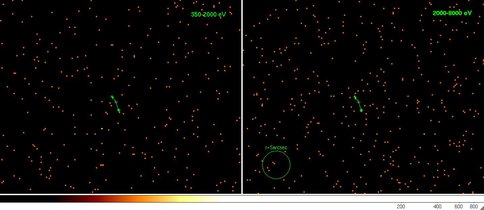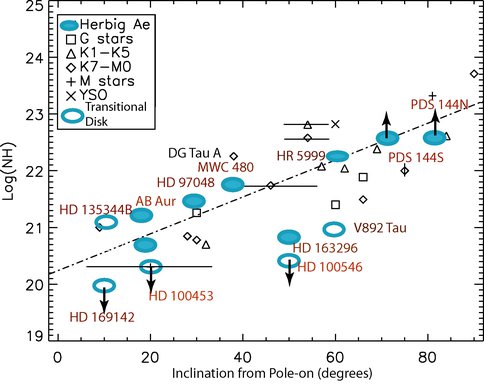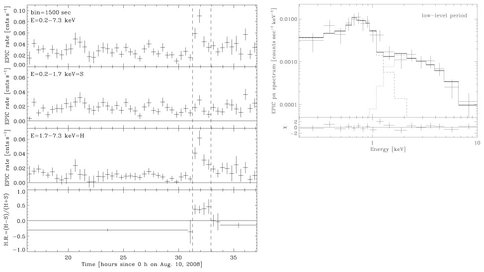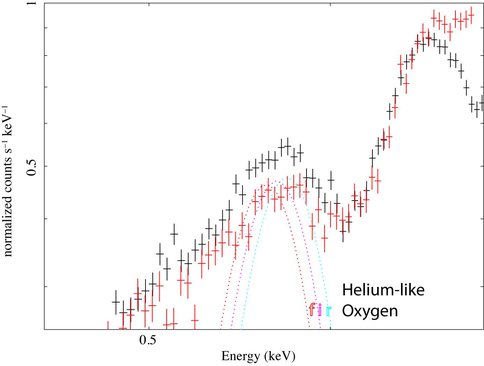2010 Annual Science Report
 NASA Goddard Space Flight Center
Reporting | SEP 2009 – AUG 2010
NASA Goddard Space Flight Center
Reporting | SEP 2009 – AUG 2010
X-Ray Emission From Intermediate Mass Young Stars, an Erupting Young Star and Diffuse Nebula in the Carina Star Forming Region
Project Summary
High-energy photons in the young stellar environment are known to be important in stimulating chemical reactions of molecules and producing pre-biotic materials. In this reporting period, we approached this problem from three directions: X-ray characteristics of young intermediate-mass stars, X-ray emission mechanism of a young star that experienced an episodic outburst, and spectral characteristics of the diffuse X-ray emission from the Carina massive star-forming region. In particular, no X-ray detection of two young intermediate-mass stars with high inclinations (PDS 144N, 144S) is consistent with a relation of X-ray absorption against the stellar inclination angle among our earlier samples. The circumstellar gas envelope around the Herbig Ae/Be stars would be thinner in higher latitudes.
Project Progress
High-energy photons in the young stellar environment are known to be important in stimulating chemical reactions of molecules and producing pre-biotic materials that might later be incorporated into comets. Observational tests are sorely needed to assess the significance of such processing for Astrobiology, and to guide development of theoretical models for chemical evolution in proto-planetary environments. In this reporting period, we approached this problem from three directions: X-ray characteristics of young intermediate-mass stars, X-ray emission mechanism of a young star that experienced an episodic outburst, and spectral characteristics of the diffuse X-ray emission from the Carina massive star-forming region.
We continued to team with GCA member Carol Grady of the GSFC Exoplanets Laboratory to study X-ray activity of two young intermediate-mass stars. One of these is the young F star SAO 206462, which is in the stage of clearing its circumstellar disk and forming planets. We surveyed the ROSAT HRI archival data and detected X-ray emission from the star at the 6.2σ level (Figure 1). The X-ray luminosity, log Lx ~29.2-29.7 ergs s-1 at d=140 pc, is similar to other accreting Herbig Ae and Fe stars and within the observed range for non-accreting ZAMS F stars. The planet formation may be affected by intense X-ray radiation from the star. The other star, PDS144, consists of an A0Ve star viewed at inclination angle i = 83 degrees (PDS 144N) and an optically detected A5Ve star with moderately high inclination (PDS 144S). The Chandra X-ray satellite observed the system for 37.3 ksec on 2010 June 24, but even with a moderately long exposure, Chandra detected X-rays from neither of the stars (Figure 2). The result limits the upper-limit hydrogen column density (NH) of ~5e22 cm-2, assuming the typical X-ray spectra of Herbig Ae stars (kT ~0.5 keV, log Lx ~29.4 ergs). This result is consistent with a relation of X-ray absorption against the stellar inclination angle among our earlier samples (Figure 3). The circumstellar gas envelope around the Herbig Ae/Be stars would be thinner in higher latitudes.
EX Lup is a pre-main sequence star, which experienced an optical outburst for seven months in 2008. XMM-Newton performed a 21h long, simultaneous X-ray and UV observation on 2008 August 10–11 – a few days before the end of its 2008 outburst. XMM-Newton detected EX Lup in X-rays with an observed flux in the 0.2–10 keV energy range of 5.4×10-14 ergs s-1 cm-2 (Figure 4). The X-ray spectrum showed two components: relatively cool plasma with light absorption (T ~4.7 MK, NH ~3.6e22 cm-2), and hot plasma that suffers strong absorption (T ~53 MK, NH ~2.7-5e22 cm-2). The soft component is most likely associated with accretion shocks, while the hard component is most likely associated with a smothered stellar corona.
Comets in the solar system emit X-rays probably through exchange of electrons between their cold neutral gas and ionized particles in the solar winds. Fundamentally, such processes could occur at any location where the hot and cold gases meet. In this process, the forbidden line emission from helium-like ions is enhanced. We found evidence for such an enhancement in X-ray spectra of the Carina diffuse plasma taken with the Suzaku observatory (Figure 5). A spectrum in the north region showed an apparently broader helium-like oxygen line than that in the south region though the CCD resolution spectra are not good enough to show the difference clearly. This result may suggest that cold stellar winds from multiple massive stars in the Carina nebula collide with hot bubbles. The X-ray calorimeter onboard Astro-H will clearly resolve these lines.
List of Publications during July 2009 – June 2010
1. “Revealing the Structure of a Pre-Transitional Disk: The Case of the Herbig F Star SAO 206462 (HD 135344B)”, C. A. Grady, G. Schneider, M. L. Sitko, G. M. Williger, K. Hamaguchi, S. D. Brittain, K. Ablordeppey, D. Apai, L. Beerman, W. J. Carpenter, K. A. Collins, M. Fukagawa, H. B. Hammel, Th. Henning, D. Hines, R. Kimes, D. K. Lynch, F. Ménard, R. Pearson, R. W. Russell, M. Silverstone, P. S. Smith, M. Troutman, D. Wilner, B. Woodgate, M. Clampin, 2009, ApJ, 699, 1822
2. “Suzaku Observation of Strong Fluorescent Iron Line Emission from the Young Stellar Object V1647 ORI During its New X-ray Outburst”, K. Hamaguchi, N. Grosso, J. H. Kastner, D. A. Weintraub, M. Richmond, 2010, ApJ, 714, L16
3. “A few days before the end of the 2008 extreme outburst of EX Lup : accretion shocks and a smothered stellar corona unveiled by XMM-Newton”, N. Grosso, K. Hamaguchi, J. H. Kastner, M. Richmond, D.A. Weintraub, 2010, accepted for publication in A&A (arXiv, 1007.2838)
4. “ Locating the Accretion Footprint on a Herbig Ae Star: MWC 480” C. A. Grady, K. Hamaguchi, G. Schneider, B. Stecklum, B. E. Woodgate, J. E. McCleary, G. M. Williger, M. L. Sitko, F. Ménard, Th. Henning, S. Brittain, M. Troutmann, B. Donehew, D. Hines, J. P. Wisniewski, D. K. Lynch, R. W. Russell, R. J. Rudy, A. N. Day, A. Shenoy, D. Wilner, M. Silverstone, J.-C. Bouret, H. Meusinger, M. Clampin, S. Kim, R. Petre, M. Sahu, M. Endres, K. A. Collins, 2010, ApJ, 719, 1565
Figure 1B. Figure 1: ROSAT HRI X-ray image of the young intermediate-mass star SAO 206462 (HD135344B).
Figure 2. Figure 2: Chandra images of the PDS144 region in the soft band (350-2000 eV, left) and the hard band (2-8 keV, right). The arrows show locations of PDS 144N and PDS 144S, respectively.
Figure 3. Figure 3: Relation between the hydrogen column density measured from X-ray spectra and the inclination angle of young intermediate-mass stars in our samples.
Figure 4. Figure 4: Left: X-ray light curves and hardness ratio curve of EX Lupi. The star showed an X-ray flare in the latter of the observation. Right: Spectrum of EX Lupi during the non-flaring period. The spectrum can be reproduced with two temperature thermal components that suffered different absorptions.
Figure 5. Figure 5: Suzaku spectra of the Carina nebula in the north region (black) and the south region (red). The dotted lines show helium-like oxygen lines (resonance, intercombination and forbidden lines from the right).
Publications
-
Grady, C. A., Hamaguchi, K., Schneider, G., Stecklum, B., Woodgate, B. E., McCleary, J. E., … Collins, K. A. (2010). LOCATING THE ACCRETION FOOTPRINT ON A HERBIG Ae STAR: MWC 480. The Astrophysical Journal, 719(2), 1565–1581. doi:10.1088/0004-637x/719/2/1565
-
Grady, C. A., Schneider, G., Sitko, M. L., Williger, G. M., Hamaguchi, K., Brittain, S. D., … Clampin, M. (2009). REVEALING THE STRUCTURE OF A PRE-TRANSITIONAL DISK: THE CASE OF THE HERBIG F STAR SAO 206462 (HD 135344B). The Astrophysical Journal, 699(2), 1822–1842. doi:10.1088/0004-637x/699/2/1822
-
Hamaguchi, K., Grosso, N., Kastner, J. H., Weintraub, D. A., & Richmond, M. (2010). SUZAKU OBSERVATION OF STRONG FLUORESCENT IRON LINE EMISSION FROM THE YOUNG STELLAR OBJECT V1647 ORI DURING ITS NEW X-RAY OUTBURST. The Astrophysical Journal, 714(1), L16–L20. doi:10.1088/2041-8205/714/1/l16
-
PROJECT INVESTIGATORS:
-
PROJECT MEMBERS:
Kenji Hamaguchi
Co-Investigator
-
RELATED OBJECTIVES:
Objective 2.2
Outer Solar System exploration
Objective 3.1
Sources of prebiotic materials and catalysts




